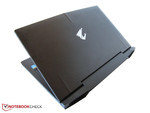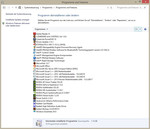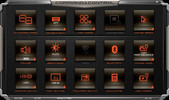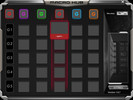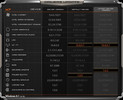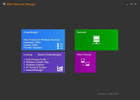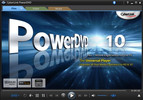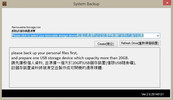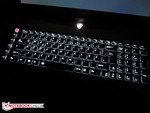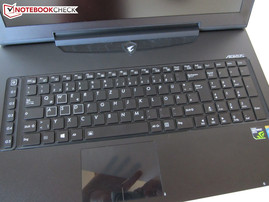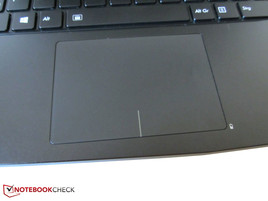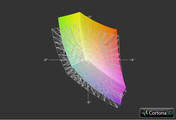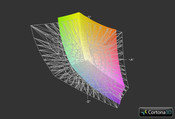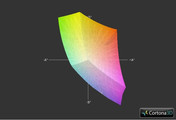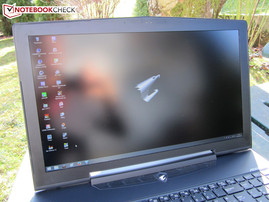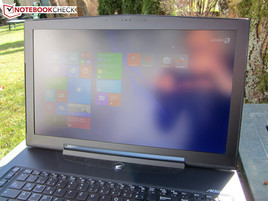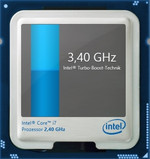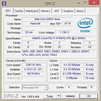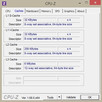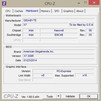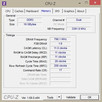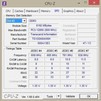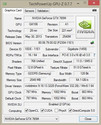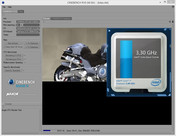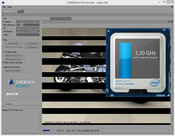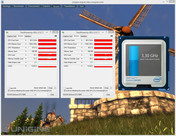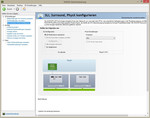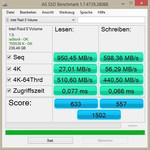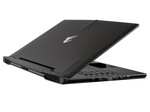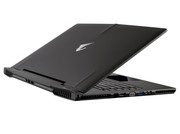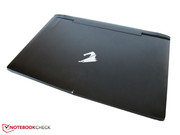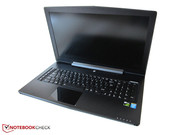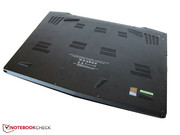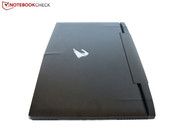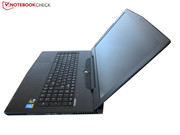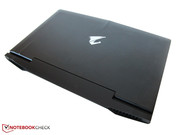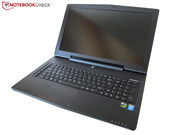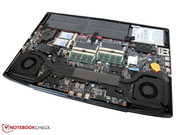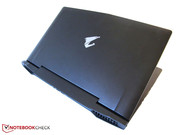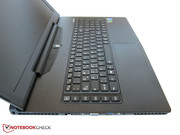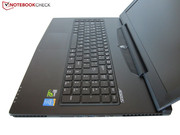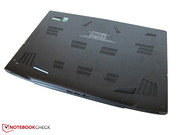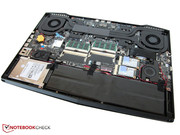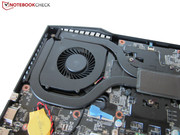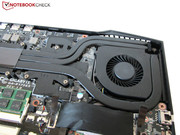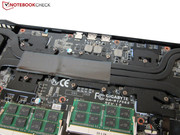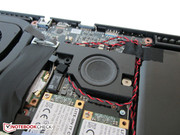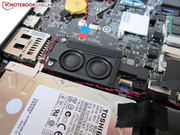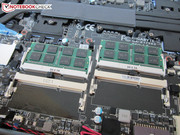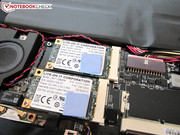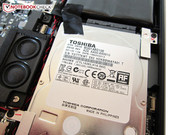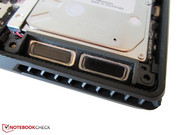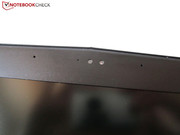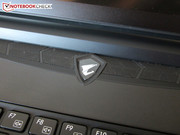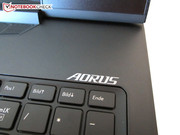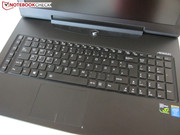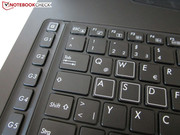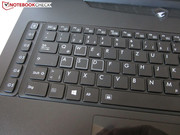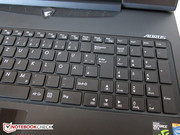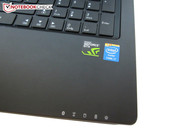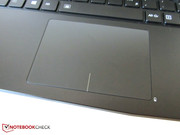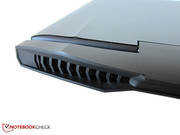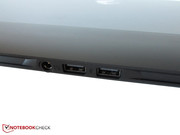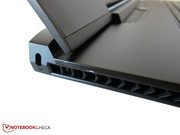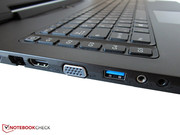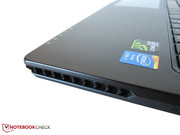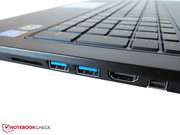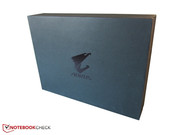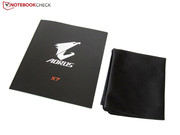Review Aorus X7 Notebook
For the original German review, see here.
Aorus is a new brand and the X7 will be its very first notebook offering. Besides the X7, the brand also includes a keyboard (Thunder K7), a headset (Thunder H7) as well as a mouse (Thunder M7).
According to the supplier, the high-end device should be available in Europe by the end of February and in the United States soon after. A price of 2,000 Euros (or $2099 in the U.S.) means it is designed for hardcore gamers who are often on the road and appreciate the thin and stylish chassis.
However, the most interesting part is the hardware equipment. Aorus manages to integrate a quad-core CPU as well as two high-end Nvidia GPUs, despite the limited space. The SLI version of the GeForce GTX 765M should provide a lot of 3D performance.
Otherwise, our review unit has 16 GB DDR3 RAM (2x 8,192 MB) and three hard drives. The 1 TB hard drive is not really spectacular, but the two mSATA SSDs in a RAID 0 configuration are certainly interesting. As it should be for a current gaming notebook, we get an anti-reflective panel with 1920x1080 pixels. An optical drive on the other hand is not available.
Case
The Aorus X7 is the right device if you are looking for a nice looking notebook without exaggerated color and design experiments. The deep black and mainly aluminum surfaces remind us of gaming products from Razer and MSI (Blade 14 and GS70 respectively), even though the distinctive back has similarities with the Asus G750. Overall, the X7 looks nice and should appeal to most gamers.
One of the most important unique features is the thin chassis construction. The Aorus X7 is one of the thinnest high-end notebooks in general (standard: more than four centimeters; ~1.6 inches) at just 2.5 centimeters (~1.0 inches). A weight of 3.25 kilograms (~7.2 pounds) is also low for a 17-inch gaming notebook. Some competitors like the Alienware 17 or Medion Erazer X7825 weigh more than 3.5 or even four kilograms (~7.7 and 8.8 pounds). The difference is even bigger when you compare it with other SLI notebooks. Clevo's P370SM barebones (One K73-3S, Schenker XMG P723) looks like a real monster in comparison. Almost 30% more weight and twice the height discourage carrying it around on a daily basis. It will be interesting to see the emissions of the X7.
But back to the topic: The build quality could be better when you consider the retail price of 2,000 Euros ($2099 in the U.S.). It starts with the keyboard, where we could see an uneven gap between it and the palm rest. However, this could also simply be a result of slight damage during shipment or an engineering defect on our particular sample. In addition, the top display frame did not permanently lock, which resulted in another visible gap. It is also not a good sign that the background illumination shines through the display frame at some spots. However, the quality impression is still on a good and competitive level when you consider all aspects.
The 17-inch device is also decent with regards to the stability. Both the lid and the keyboard could have been a bit more torsion-resistant, but the stability is acceptable for an ultrabook-like device. This also applies for the hinges and you can easily open the lid with one hand.
Connectivity
Ports
Apart from the meager audio connectivity (headphones + microphone) and the missing eSATA or FireWire port, respectively, the port variety is lush. We especially want to mention the digital video ports (Mini DisplayPort, HDMI & Surround), which enable a triple-screen setup with three external displays. Five USB ports (3x USB 3.0, 2x USB 2.0) also deserve credit.
The high connectivity rating also benefits from the Kensington Lock, SD card reader and a VGA port. All the ports are distributed across the back and the two sides, so neither left nor right-handers should have any problems.
Communication
The network adaptor Killer e2200 Gigabit Ethernet controller is provided by Qualcomm Atheros. You can monitor and, if necessary, adjust the data traffic via the preloaded Network Manager.
Wireless connections are supported by the Intel Centrino Wireless-AC 7260 adaptor. It supports – as the name already suggests – the latest ac-standard. WLAN 802.11 b/g/n and Bluetooth 4.0 are obviously available as well and you can use 2.4 and 5 GHz networks.
Maintenance
You can remove the whole bottom cover if you have reasonable muscle power and a Tx5 Torx screwdriver. Under this cover is a clever cooling system, which consists of two fans and several heat pipes (compare the pictures on the right).
Furthermore, you get access to a 2.5-inch drive bay, two mSATA slots and four memory slots. The wireless module and the battery are also accessible, but dismantling the latter can be tricky. Both the processor and the graphics cards are soldered onto the mainboard; a future upgrade is therefore not an option.
Software
Aorus does not include a lot of unnecessary bloatware and preloads the notebook with some of its own tools instead. Let us start with a tool called Power Switch, which can be found in the task bar so you can comfortably turn the notebook off (keyword Windows 8). Even more interesting is the so-called Command & Control, which combines several settings in one simple tool. Amongst others, you can change the fan mode (Stealth, Auto & Turbo).
On the left, next to the keyboard are some macro keys (G1-G5) that can be configured via the Macro Hub. The application Drivers Update (see screenshot below) is also a nice idea. Finally, you get a media player from Cyberlink and a tool for system backups. PDF-files are handled by Acrobat Reader XI and other documents can be edited with a trial version of Office 365.
Accessories
The scope of delivery is a bit disappointing for a 2,000 Euros ($2099 in the U.S.) notebook. Besides a 153 x 75 x 30 millimeters (~6 x 3 x 1.2 inches) 180-Watt power supply unit, customers only get a cleaning cloth and a small manual. Neither recovery DVDs nor driver DVDs are provided.
Warranty
The manufacturer grants a warranty of two years for the notebook (12 months for the battery).
Input Devices
Keyboard
The chiclet keyboard holds a few surprises for the user. First of all, you get a two-stage background illumination, so you can comfortably use the Aorus X7 in dark environments.
Another highlight is the already mentioned macro keys, which can be assigned with five functions each. Passionate gamers therefore have 25 additional keys. The macro area does however take some time getting used to. The standard keyboard does not start directly at the left side of the case, so you might get some occasional typos.
It is a good keyboard, but not an excellent one; there is still room for improvement. Pressure point and stroke are usable, and the same applies for the typing noise as well as the layout. We were convinced by the layout, except for the combined Ins/Del key. Gamers will be happy about the specially marked WASD keys and the standard sized arrow keys.
Appropriate size: The keys are convenient at 15 x 15 millimeters (spacing: ~3 millimeters). The half-size F-row can convince us with dozens of comfort features. Besides an audio and multimedia control, the X7 also has a switch for the wireless adapter, the display, the touchpad as well as the webcam.
Touchpad
The touchpad is certainly one of the biggest problems. Aorus decided to integrate a glossy ClickPad (Elan Smart-Pad) that has no dedicated buttons. Similar to other ClickPads, the model does lack some stability and feedback. Left and right clicks, respectively, are not always recognized reliably. The sticky coating also results in a high susceptibility towards dirt and moderate gliding capabilities.
We also want to highlight the good multi-touch support, which allows fast scrolling, zooming and turning. The size is not bad either at 10.0 x 7.0 centimeters (~4 x 2.8 inches) and the precision is not affected by the moderate gliding capabilities.
Display
The 17.3-inch display has the designation AU Optronics B173HW02 V1. Compared to standard panels, which are often used in inexpensive multimedia and office notebooks, the display does pretty well, but you should not expect any new records.
| |||||||||||||||||||||||||
Brightness Distribution: 83 %
Center on Battery: 282 cd/m²
Contrast: 533:1 (Black: 0.57 cd/m²)
ΔE ColorChecker Calman: 10.55 | ∀{0.5-29.43 Ø4.78}
ΔE Greyscale Calman: 11.29 | ∀{0.09-98 Ø5}
64% AdobeRGB 1998 (Argyll 1.6.3 3D)
64.3% AdobeRGB 1998 (Argyll 3D)
88% sRGB (Argyll 3D)
66.6% Display P3 (Argyll 3D)
Gamma: 2.19
CCT: 13131 K
An average brightness of 278 cd/m² is more than 15% behind the very popular Chi Mei N173HGE (~320 cd/m² @ Schenker XMG C703) that is used for many rivals. The difference is even bigger in regard to the contrast ratio: Almost 1000:1 for the Chi Mei while the AU Optronics inside the X7 manages around 530:1. This result is not bad by any means, but not overwhelming either. The main reason for the average contrast is the mediocre black value: 0.57 cd/m² lets black contents appear slightly grayish.
Demanding users could be annoyed by the slight screen bleeding on the left and right of the display frame as well as the fine pixel grid. However, you can only see the latter from a very short distance. We also have to criticize the color accuracy. Our CalMAN measurements show a fairly high deviation for the Aorus X7 in terms of grayscale presentation and color balance. Similar to most rivals there is a shift towards blue.
There is hardly any criticism from a gamer’s perspective because the picture is rich and saturated. Subjectively, the picture is not very different from the Chi Mei N173HGE and the color space is even slightly bigger with 64 to 58% AdobeRGB. Even though the brightness is reduced on battery power, you can still use the Aorus X7 outdoors. Annoying reflections are tolerable thanks to the matte display surface.
As expected, the viewing angle stability cannot keep up with an IPS panel. Vertical changes quickly result in picture distortions. The situation is much better with horizontal shifts, so the overall rating is still good. Note: The brightness is automatically controlled out of the box; we deactivated this feature for our review (Command & Control).
Performance
Processor
The Core i7-4700HQ is a powerful high-end CPU from Intel's Haswell generation (22 nm manufacturing) with four native and four virtual cores. Besides Hyperthreading, the quad-core also supports automatic overclocking via Turbo Boost.
Similar to its sibling Core i7-4700MQ, the clock can be raised from 2.4 up to 3.4 GHz under load. TDP and L3 cache are also identical with 47 Watts and 6 MB, respectively. The integrated HD Graphics 4600 GPU is deactivated in the Aorus X7; Nvidia's Optimus technology is not supported because of the SLI configuration.
Turbo Boost
The Turbo Boost can live up to expectations during normal operation. 3.2-3.4 GHz during single-core applications and 3.0-3.2 GHz during multi-core applications indicate high performance. Only extreme conditions, which hardly occur in practice, result in the nominal clock of the Core i7-4700HQ. Our impractical stress test showed a slight throttling to around 2 GHz. Both GeForce GPUs always ran with their maximum clock (902 MHz via GPU Boost) during 3D operation.
CPU Performance
The processor performance is on a typical level for a Core i7-4700HQ. The Gigabyte P34G or Asus N56JR could also produce results of 134 points in the Single-CPU test of Cinebench R15 and 633 points in the Multi-CPU test. For comparison: The Core i7-4700MQ inside the Medion Erazer X7825 managed equal 135 and 634 points in our review. Higher cost quad-cores are of limited value for gamers.
| Cinebench R11.5 | |
| CPU Single 64Bit (sort by value) | |
| Core i7-4700HQ | |
| Core i7-4700MQ | |
| Core i7-4800MQ | |
| CPU Multi 64Bit (sort by value) | |
| Core i7-4700HQ | |
| Core i7-4700MQ | |
| Core i7-4800MQ | |
Graphics
An SLI configuration with two GTX 765M cards is not only very rare, but also extremely powerful. The high-end chip does not set any records with 768 Unified Shaders and 2 GB GDDR5 memory via a 128-bit memory interface, but the combination of two cards can actually threaten the currently fastest GPU.
The current top version GTX 780M, which is also produced in 28 nm, has 1,536 CUDA cores and 4,096 MB video memory (interface: 256-bit). Clocks on the other hand, are very similar: The core of the GTX 765M usually runs at 850 MHz and the GTX 780M is specified at 823 MHz.
GPU Performance
Our GPU benchmarks show that the SLI configuration is at the very top performance level. A 3DMark Fire Strike GPU score of 4,795 points for the Aorus X7 is roughly 70% faster than a notebook with a single GTX 765M (2,768 points @ Schenker XMG A503) and the GeForce GTX 770M is beaten as well, even though it only falls behind by around 25% (3,569 points @ Gigabyte P25W). The fastest card is the GTX 780M, which managed 14% more points (5,465 points) inside the Alienware 17.
The Unigine Heaven 3.0 benchmark (1920x1080, High, Tessellation normal) supports this order: 69.9 fps are closer to the result of the GTX 780M (76 fps @ Schenker XMG P703) than to the result of the GTX 770M (49.5 fps @ One K73-3N). A single GTX 765 on the other hand has no chance (34.3 fps @ Alienware 14).
All GPU results were determined with the fan setting Auto. We do not recommend using the Turbo mode of the Command & Control center. The temperature does not really improve, but the notebook gets noticeably louder and it does not seem to have any effect on the performance, either. 3DMark 2013 more or less shows the same result.
| 3DMark 11 - 1280x720 Performance GPU (sort by value) | |
| GeForce GTX 765M SLI (332.28) | |
| GeForce GTX 765M (327.23) | |
| GeForce GTX 770M (332.21) | |
| GeForce GTX 780M (326.45) | |
| 3DMark Vantage - 1280x1024 P GPU no PhysX (sort by value) | |
| GeForce GTX 765M SLI (332.28) | |
| GeForce GTX 765M (327.23) | |
| GeForce GTX 770M (332.21) | |
| GeForce GTX 780M (326.45) | |
| 3DMark 06 Standard Score | 26226 points | |
| 3DMark Vantage P Result | 24399 points | |
| 3DMark 11 Performance | 7355 points | |
| 3DMark Ice Storm Standard Score | 123538 points | |
| 3DMark Cloud Gate Standard Score | 17729 points | |
| 3DMark Fire Strike Score | 4158 points | |
Help | ||
Storage Solution
The Aorus X7 does show off in relation to the storage solution. Aorus equips the 17-inch device with two SSDs in a RAID 0 configuration. More precisely two mSATA models with a capacity of 128 GB each (Lite-On LMT-128M6M). The RAID configuration guarantees excellent performance that clearly beats larger 2.5-inch drives like the Samsung SSD 840 Evo.
A sequential transfer rate of 950 MB/s (read) is currently beyond reach for a Solid State Drive without RAID. The same applies for the sequential writes of almost 600 MB/s. The 250 GB version of the Samsung 840 Evo inside the Schenker XMG A503 ‘only’ managed 510 and 462 MB/s, respectively. Access times of 0.077 ms and 0.066 ms are also very good (840 Evo: 0.057 @ read, 0.034 ms @ write). Only the performance of small 4K data blocks falls behind.
The two mSATA drives are accompanied by a 1,000 GB HDD from Toshiba. It has the designation MQ01ABD100 and is very popular amongst notebook manufacturers, which is not surprising when you look at the performance. Even though the large drive does not run at 7,200 rpm, CrystalDiskMark still determines sequential transfer rates of more than 110 MB/s while most 5,400 rpm drives stay below 100 MB/s. However, you will probably only use the conventional drive for videos, pictures and music once you have experienced the advantages of an SSD.
System Performance
The RAID configuration can really improve the system performance. A PCMark 7 score of 5,825 points is at the top of our charts and the Aorus X7 does not have to hide behind bulkier gaming notebooks like the Asus G750JH-T4080H (5,838 points) or Bullman C-Class 5 (5,790 points).
| PCMark 7 Score | 5825 points | |
| PCMark 8 Home Score Accelerated v2 | 3857 points | |
| PCMark 8 Creative Score Accelerated v2 | 3922 points | |
| PCMark 8 Work Score Accelerated v2 | 4587 points | |
Help | ||
Gaming Performance
It is apparent that Nvidia creates good drivers when you look at the gaming benchmarks. We noticed a massive performance improvement with the second GPU in 13 of 14 tested titles, most of the time up to 100% (ForceWare 332.28). Only X-Plane 10, which is not perfectly optimized in general, did not show any improvement and was comparable to a single GTX 765M.
Otherwise the SLI combination does not have any problems with current titles either. Even complex games like Battlefield 4, Metro: Last Light or Call of Duty: Ghosts run with more than 30 fps at the maximum settings. There are just a few exceptions where you will see dropped frames (e.g. Crysis 3), but almost every game runs smoothly and looks good if you do not exaggerate the settings or the anti-aliasing.
However, there are well-known problems like the high driver dependency and micro-stutters, so we would still recommend a single high-end GPU for core gamers as well as less experienced users. The GeForce GTX 780M offers roughly the same level of performance as the SLI combination; a GTX 770M is around 30% slower.
| GPU | Overall Performance @ Ultra Settings |
|---|---|
| GeForce GTX 765M SLI | Base (average of 10 games, rounded) |
| GeForce GTX 780M | +/-0% |
| GeForce GTX 770M | -30% |
| GeForce GTX 765M | -50% |
| low | med. | high | ultra | |
|---|---|---|---|---|
| Guild Wars 2 (2012) | 62.2 | 41.8 | ||
| Hitman: Absolution (2012) | 52.2 | 29.5 | ||
| Far Cry 3 (2012) | 79.5 | 30.7 | ||
| Crysis 3 (2013) | 71.5 | 23.7 | ||
| Tomb Raider (2013) | 135.1 | 64.2 | ||
| BioShock Infinite (2013) | 142.1 | 57.4 | ||
| Metro: Last Light (2013) | 51 | 33 | ||
| GRID 2 (2013) | 128.5 | 65.4 | ||
| Dota 2 (2013) | 119.2 | 115.6 | 102 | |
| Saints Row IV (2013) | 83.7 | 72.6 | 62.8 | 48.8 |
| F1 2013 (2013) | 119 | 115 | 111 | 96 |
| Battlefield 4 (2013) | 181.1 | 136.9 | 101.9 | 40.3 |
| Call of Duty: Ghosts (2013) | 91.4 | 83.3 | 65 | 40.7 |
| X-Plane 10.25 (2013) | 103.4 | 49.4 | 26.4 | 14.5 |
Emissions
System Noise
The Aorus X7 is pretty quiet during idle and the fans are even completely deactivated if there is absolutely no load. All you can hear in this case is the slight murmur of the hard drive (~30-31 dB(A)), and it is completely silent once the hard drive is deactivated. The fans are however activated during light workloads (office, video, web browsing etc.) and audible at around 32 dB(A), so we recommend you adjust the Fan Tweak in the Command & Control center and – as long as you don't play any games – activate the Stealth mode.
More complex 3D applications, however, require the Auto fan setting. 3DMark 06, which is the basis for our load operation, results in clearly audible and for many users annoying 46 dB(A), whereby the noise fluctuates between 41 and 48 dB(A) in our GPU tests. 51 dB(A) during the CPU tests and 51 dB(A) under maximum load are also very loud (54 dB(A) @ Turbo). MSI's GS70, which is also very thin, but only has a single GPU, is louder during idle (~34-35 dB(A)), but the load results are around 2 dB(A) lower in return.
Noise level
| Idle |
| 30.4 / 30.6 / 30.8 dB(A) |
| Load |
| 46.3 / 51 dB(A) |
 | ||
30 dB silent 40 dB(A) audible 50 dB(A) loud |
||
min: | ||
Temperature
Another problem is the temperature development. Similar to most thin notebooks we can see that the components get really warm – clever cooling or not. Our stress test with Prime95 and the Unigine Heaven benchmark almost resulted in 90 °C (194 °F) for one of the two GeForce GPUs (you can see why we did not use FurMark in the Energy Management section).
However, the main problem is the Core i7-4700HQ, which can reach up to 100 °C (212 °F) under extreme circumstances (according to CPUID HWMonitor). We already know this phenomenon from other reviews, Intel's Haswell generation seems to be pretty hot-headed in general. A maximum temperature of 37 °C (98.6 °F) for the storage is not low, either.
Another issue is the surface temperatures that get perceptibly warm during idle. We can measure 33 °C (91.4 °F) at the top and 35 °C (95 °F) at the bottom on average. The MSI GS70 Stealth is significantly cooler (25/26 °C; 77/78.8 °F). Our measurements during the stress test cannot be compared because of the different software. A maximum temperature of 51 °C (123.8 °F) around the fan and up to 41 °C (105.8 °F) at the palm rest certainly indicates a powerful hardware combination. Thicker gaming notebooks like the Schenker XMG P703 or the One K73-3N are much cooler in this scenario.
(-) The maximum temperature on the upper side is 48.5 °C / 119 F, compared to the average of 40.4 °C / 105 F, ranging from 21.2 to 68.8 °C for the class Gaming.
(-) The bottom heats up to a maximum of 50.5 °C / 123 F, compared to the average of 43.3 °C / 110 F
(±) In idle usage, the average temperature for the upper side is 33.4 °C / 92 F, compared to the device average of 33.9 °C / 93 F.
(-) The palmrests and touchpad can get very hot to the touch with a maximum of 40.5 °C / 104.9 F.
(-) The average temperature of the palmrest area of similar devices was 28.9 °C / 84 F (-11.6 °C / -20.9 F).
Speakers
The sound quality cannot really meet the high-end expectations, either. Movies, games and music do not sound very good, despite the decent preconditions (two speakers at the front + two subwoofers). However, it is very common for notebooks that the speakers lack precision, balance and naturalness. Sound enthusiasts without a headset or external speakers should look for another device. The Dynaudio system inside the MSI GT70 is currently the reference.
Energy Management
Power Consumption
We use the similarly powerful Schenker XMG P723 (Core i7-4800MQ & GeForce GTX 765M SLI) to assess the power consumption. The dual GPU notebook is based on the Clevo P370SM barebones and consumes a bit more during idle. While the Aorus rival consumes between 34 and 45 Watts, we can measure between 26-34 Watts for the Aorus X7. 3DMark 06 changes the situation, even though the difference (122 vs. 130 Watts) is negligible.
Unfortunately, we could not perform the stress test with the tools FurMark and Prime95 because the power supply shut down after a short time and the notebook only ran on battery power. We think the power supply unit is overstrained under extreme load and the provided 180 Watts are not sufficient. Even the Unigine Heaven benchmark, which does not stress the system as much, resulted in a consumption of up to 192 Watts at the socket according to our measurement device.
We would strongly recommend that the manufacturer integrate a larger power supply unit with 200-240 Watts. Some gamers might ignore the notebook otherwise.
| Off / Standby | |
| Idle | |
| Load |
|
Key:
min: | |
Battery Runtime
Besides the emissions and consumption measurements, we also performed the battery runtime tests with activated keyboard illumination and the second GTX 765M. 1.5-3 hours are okay for an SLI notebook. The XMG P723 is on the same level, despite the larger battery (89 vs. 73 Wh).
Verdict
Too good to be true? This question crossed our minds when the Aorus X7 was introduced. An ultra-thin chassis with two high-end GPUs is an absolute novelty and certainly deserves the related attention.
Our review, however, showed that it was not a full success. Yes, the manufacturer managed a small wonder with the realization, but nice looks and the thin construction are not very important when the device gets inconveniently warm and loud during gaming. The Aorus is definitely not the right choice for sensitive gamers.
Other issues like the bad gliding capabilities of the touchpad surface and the insufficient power supply unit also affect the overall rating. Build quality and the sound system could be improved as well.
Ignore these points of criticism and the Aorus X7 can justify its price tag. The SLI system and the SSD RAID provide excellent performance, both with 3D applications and everyday tasks.
The possibility to play games on three displays is also tempting. Thanks to the decent non-glare panel, you will also have a good experience with the integrated display. The manufacturer uses its own solutions for the keyboard (macro keys), the software and the design. The detachable bottom cover improves maintainability (Torx screwdriver required!).
Overall, the price of 2,000 Euros ($2099 in the U.S.) is reasonable given the pros and cons of the manufacturer's first notebook outing.
In Comparison
| Call of Duty: Ghosts - 1920x1080 Extra / High / HBAO+ / No dynamic fur AA:4x MS (sort by value) | |
| GeForce GTX 765M SLI (332.28) | |
| GeForce GTX 765M (mixed driver) | |
| GeForce GTX 770M (mixed driver) | |
| GeForce GTX 780M (mixed driver) | |
| Battlefield 4 - 1920x1080 Ultra Preset AA:4x MS (sort by value) | |
| GeForce GTX 765M SLI (332.28) | |
| GeForce GTX 765M (mixed driver) | |
| GeForce GTX 770M (mixed driver) | |
| GeForce GTX 780M (mixed driver) | |
| F1 2013 - 1920x1080 Ultra Preset AA:4x MS (sort by value) | |
| GeForce GTX 765M SLI (332.28) | |
| GeForce GTX 765M (mixed driver) | |
| GeForce GTX 770M (mixed driver) | |
| GeForce GTX 780M (mixed driver) | |
| Saints Row IV - 1920x1080 Ultra Preset AA:8x MS AF:16x (sort by value) | |
| GeForce GTX 765M SLI (332.28) | |
| GeForce GTX 765M (mixed driver) | |
| GeForce GTX 770M (mixed driver) | |
| GeForce GTX 780M (mixed driver) | |
| Dota 2 - 1920x1080 High / On, Render Quality: 100 % (sort by value) | |
| GeForce GTX 765M SLI (332.28) | |
| GeForce GTX 765M (mixed driver) | |
| GeForce GTX 770M (mixed driver) | |
| GeForce GTX 780M (mixed driver) | |
| GRID 2 - 1920x1080 Ultra Preset AA:4xMS (sort by value) | |
| GeForce GTX 765M SLI (332.28) | |
| Metro: Last Light - 1920x1080 Very High (DX11) AF:16x (sort by value) | |
| GeForce GTX 765M SLI (332.28) | |
| BioShock Infinite - 1920x1080 Ultra Preset, DX11 (DDOF) (sort by value) | |
| GeForce GTX 765M SLI (332.28) | |
| GeForce GTX 765M (311.27) | |
| GeForce GTX 770M (311.27) | |
| GeForce GTX 780M (311.27) | |
| Tomb Raider - 1920x1080 Ultra Preset AA:FX AF:16x (sort by value) | |
| GeForce GTX 765M SLI (332.28) | |
| GeForce GTX 765M (311.27) | |
| GeForce GTX 770M (311.27) | |
| GeForce GTX 780M (311.27) | |
| Crysis 3 - 1920x1080 Very High Preset AA:2xSM AF:16x (sort by value) | |
| GeForce GTX 765M SLI (332.28) | |
| GeForce GTX 765M (311.27) | |
| GeForce GTX 770M (311.27) | |
| GeForce GTX 780M (311.27) | |
| Far Cry 3 - 1920x1080 DX11 Ultra Preset (HDAO, Enhanced Alpha To Coverage) AA:4x MS (sort by value) | |
| GeForce GTX 765M SLI (332.28) | |
| GeForce GTX 765M (311.27) | |
| GeForce GTX 770M (311.27) | |
| GeForce GTX 780M (311.27) | |
| Hitman: Absolution - 1920x1080 Ultra Preset AA:4xMS AF:16x (sort by value) | |
| GeForce GTX 765M SLI (332.28) | |
| GeForce GTX 765M (311.27) | |
| GeForce GTX 770M (311.27) | |
| GeForce GTX 780M (311.27) | |
| Guild Wars 2 - 1920x1080 All Maximum / On AA:FX (sort by value) | |
| GeForce GTX 765M SLI (332.28) | |
| GeForce GTX 765M (311.27) | |
| GeForce GTX 770M (311.27) | |
| GeForce GTX 780M (311.27) | |





